Month 11:29, Week 4:7 (Shibi'i/Sukkot), Year:Day 5945:324 AM
2Exodus 8/40
Gregorian Calendar: Monday 31 January 2022
Book of Revelation VIII
The 7 Asian Assemblies - 2. Smyrna
(Revelation 2:8-11)
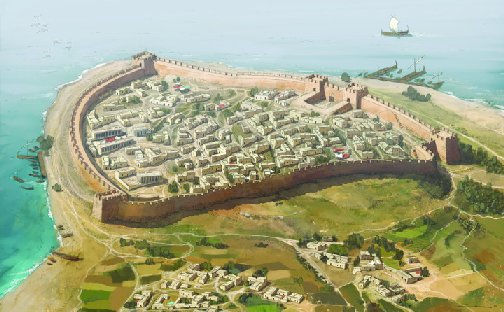
Continued from Part 8
Introduction
Shabbat shalom kol beit Yisra'el and Mishpachah and welcome back to the eighth part on our study of the Book of Revelation.
Asia, Biblical Geography and the 'World'
Last week we devoted the entire sermon to Ephesus, the capital of Anatolia and the Messianic Community's (Church's) headquarters under the apostle John of the Roman Province of Asia or 'Asia Minor' (Little Asia), not to be confused with the continent of Asia which stretches from the Bosphorus and Constantinople to Japan and eastern Siberia. Always remember that when the Bible - and in particular the Messianic Scriptures (New Testament) - speaks of 'the world', most of the time the reference is to the known world, which in New Testament times would have been the Roman Empire, North Africa as far south as Ethiopia, the Levant (the eastern part of the Mediterranean) and Persia, with a few knowing about distant India and China. Thus when the city clerk said, "Men of Ephesus, doesn't all the world know that the city of Ephesus is the guardian of the temple of the great Artemis and of her image, which fell from heaven?" (Acts 19:35-36, NIV) or when "Agabus stood up and showed by the Ruach (Spirit) that there was going to be a great famine throughout all the world, which also happened in the days of Claudius Caesar" (Acts 11:28, NKJV), we know it is the world as currently known by the Romans that is being referred to, a reason why the New International Versiion (NIV) and other dynamic-equivalent English translations (e.g. NLT, JNT/CJB) say the famine will affect "the entire Roman world" (Acts 11:28, NIV) from Britain to Egypt and from Mauretania to Armenia [1]. So don't be like some narrow-minded and ill-informed KJV-Onlyer who criticises all modern versions like the NIV for interpeting when that interpretation is proven to be valid. Every version has its strengths and weaknesses, including the KJV.
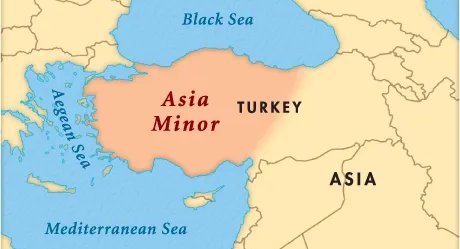
Use the Correct Interpretive Lenses
If we remember this, we will also remember to read the Scriptures through the lenses and knowledge-bases of the ancient writers themselves and not get confused when they appear to misalign with our 21st century vocabularly and knowledge. I mention this because a Vietnamese friend of mine got excited the other day when she saw the title of last week's sermon, The 7 Asian Assemblies, and automatically thought of the 'Asia' in the Far East with which she was familiar. I also mention this to you now to prep you for tomorrow's Rosh Chodesh talk in which we shall be dismantling some of the outrageous prophetic theories of modern believers misreading the Book of Ezekiel and applying it to events in modern Russia and Ukraine. So to the readers of the Book of Revelation the rest of the planet outside the Roman world was largely unknown, including the Americas and sub-Saharan Africa, the Far East, Australasia and Polynesia. In most cases, save where Elohim (God) speaks directly, the perspective is that of the writer and his limited knowledge-base. Roman Asia is not the same as the 'Asia' we speak of today. Bear this in mind when we come to the prophetic parts of the Book of Revelation from chapter 4 onwards.
Recap on Ephesus
Last sabbath we learned how Yah'shua (Jesus) used dominant symbols in Ephesus - the Temple of Artemis (Diana), its beautiful garden precincts and its 'Asylum Tree' as jumping off points to remind readers of the true Temple of Yahweh, the true Paradise that was Eden, and the Tree of Life in the same way Yah'shua (Jesus) uses the man-made festival of Hanukkah, also known as the Feast of Dedication [of the Temple], with its fabulous light displays as an illustration of how He is the Light of the world (Jn.10:22ff; 8:12; 9:5).
Pagan Symbols as Stepping Stones to the True Ones
It is important for us to understand that Yahweh will use whatever is uppermost in public consciousness, even if it is based on something untrue (like the Temple of Artemis, Hanukkah or even Christmas) to teach a true principle. We must never assume that He is automatically endorsing whatever the current pagan belief, rabbinical tradition or superstition happens to be. We do this in every age. Paul does the same thing with the Greek altar dedicated "to an unknown god" in Athens (Ac.17:23), using it to grab his listeners' attention and point them to the true Elohim (God), Yahweh, whom the Athenians did not yet know. It's important you become aware of this so that you do not leap to false conclusions as so many uninformed persons do when reading the Bible.
From Ephesus to Smyrna
So that was the story of Ephesus, whose history we traced from 500 BC to its sacking by the Goths, its rebuilding, later capture by the Turks and expulsion of the original Greek Christian inhabitants in the 1400's. It was a long history but today we're going to look at a city with an even longer history.
2. THE CONGREGATION AT SMYRNA
The Fivefold Pattern
So let's now go to today's text about the second congregation, remembering as we read through it the five-fold pattern or tavnith of all of these messages, namely:
- (a) a command to write to the pastor;
- (b) a pronouncement formula combined with a self-description by Messiah;
- (c) a statement of something the Master knows about that congregation leading to exhortation, commendations, and/or accusations;
- (d) a command to heed what the Ruach (Spirit) is saying to the congregations; and finally
- (e) a promise of deliverance made to that congregation's overcomers.
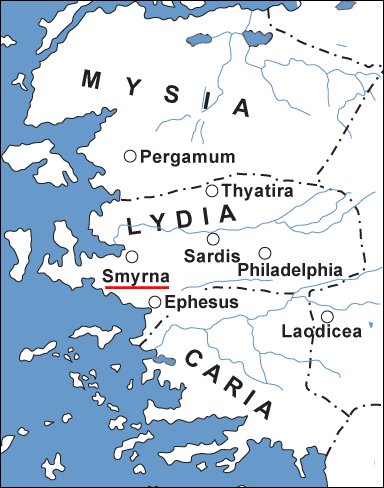
Revelation 2:8-11
We'll, as usual, be using the New King James Version (NKJV) as our ground text, so if you'd like to turn with me to chapter 2 and verse 8 of the Book of Revelation, we'll see what spiritual gems we can unearth there:
"8 And to the malak (messanger, angel, pastor) of the assembly (congregation, church) in Smyrna (modern İzmir) write, 'These things says the First and the Last (Alef/Taw, Alpha/Omega), who was dead, and came to life: 9 I know your works, tribulation, and poverty (but you are rich); and I know the blasphemy ('slander[ed/s]' - NRSV, ESV, NIV, NLT, NEB, JBP, Barclay; 'insults' - JNT/CJB; 'abused+reviled+slandered' - AmpV) of (by) those who say they are Judahites (Jews) (and are not 'self-styled Jews' - KNT), but are a synagogue ('congregation' - HRV) of Satan. 10 Do not fear any of those things which you are about to suffer. Indeed, the devil is about to throw some of you into prison, that you may be tested, and you will have tribulation ('affliction' - KNT, NRSV, HRV; 'trouble[s]' - Barclay, TEV; 'distress' - JBP; 'persecution' - NIV, NLT) ten days (''ten days'' - NLT). Be faithful until death, and I will give you the crown of life. 11 He who has an ear, let him hear what the Ruach (Spirit) says to the assemblies (congregations, churches). He who overcomes ('conquers' - KNT, RSV, NRSV, ESV; 'victor[ious/ly]' - Barclay, JBP, NLT, NEB, JNT/CJB, TEV) shall not be hurt by the second death" (Rev.2:8-11, NKJV).
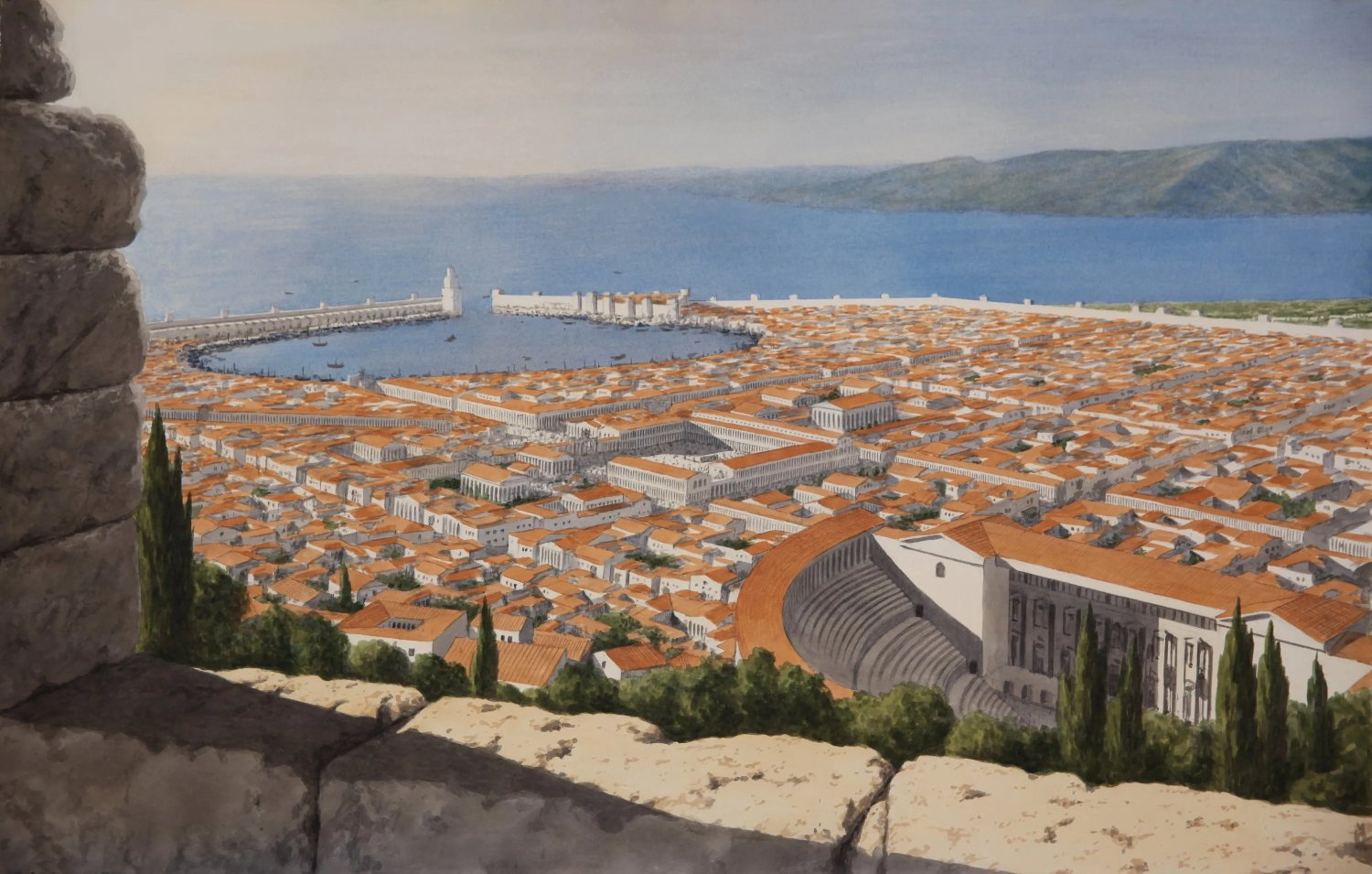 The ancient city of Smyrna with its harbour, looking west
The ancient city of Smyrna with its harbour, looking west
Faithfulness, Historical Justice and the Promise of Eternal Life
The dominant theme of the message to Smyrna is the importance of faithfulness. It is a powerful exhoration to remain faithful through patient endurance in suffering. It comes with the assurance that Yahweh is in ultimate control of history, both of our nations and of the individuals within them. That's important for us right now as we pass through a time of great confusion and uncertainty. The year, as we have already seen, is about AD 95 in the reign of Roman Emperor Domitian. As we're about to see, this city was a survivor because it was an overcomer. It still exists today only it is known by its Turkish name İzmir even though its original Greek propulation was either massacred or expelled as recently as 1922-3. So it's amazing to me that Smyrna hung on for so long when all the other cities of the seven congregations of Asia Minor disappeared centuries ago. Coupled to Yahweh's promise to one day put to right all the injustices of history is the even more important promise of eternal life to believers (which even now we are enjoying as a kind of partial downpayment) who hold out against persecution. And His promises are reliable. True believers have guts - courage - endurance - because they know in Whom they are trusting, for He is trustworthy.
Faithfulness in Suffering
And here we need to be reminded, once again, that Yah'shua (Jesus) never said that by being faithful to Him we would avoid trouble, hardship, suffering or persecution in life. Rather, we must be faithful to Him in our suffering as He was faithful to us in His. Only then will our emunah (faith) not only prove itself genuine but give us the means to pass through it strengthened and spiritually refined. We remain faithful by keeping our eyes on Messiah (Christ) when we might wish to turn to our own meager resources, and by obeying His mitzvot (commandments), which are His, and our, Heavenly Father's mitzvot (commandments). They are the tried and tested medium through which authentic faith operates. We need to remind ourselves and others of His promises of help and comfort now, and of complete simcha (joy) and perfect shalom (peace) both in the here-and-now as well as its fullness in our eternal life-to-come.
The End of Greek Christian Smyrna
As a city, Smyrna or İzmir is over 2,000 years old. It has a long, colourful and painful history, as Yah'shua (Jesus) warned that it would. But what did He mean when He said the believers there would soon be afflicted for "ten days"? Clearly this number is symbolic but does it mean 10 literal days, 10 weeks, 10 months, 10 years, 10 decades, 10 centuries, or something else? Commentators have, of course, speculated as usual. Here we must think as the ancients did. 10 is the scriptural number of completeness and order so at its most basic level is means that the persecution will be short, sharp, complete, and affect everyone, and will do a complete job in perfecting the community of believers. What's the first thing a Tanakh or Old Testament-believing people think of in hearing the number '10'? Yes, the Ten Commandments, of course, as these are a summary of all the commandments. If we are abiding by these naturally, spontaneously, and joyfully, in spite of adversity, we will know we're pleasing Yahweh Knowing also, as we do, that prophecy repeats itself in cycles through history, I think you will see how this revelation can apply to us in our present situation, as we consider the history of Smyrna.
The Relationship Between Smyrna and Ephesus
Smyra is only about 50 miles north of Ephesus so the two cities would have been in close contact with one another. Ephesus, with its pagan temple of Artemis or Diana, was undoubtedly the capital of Roman Asia and the western part of Anatolia. But Smyrna was a very close rival as far as fame was concerned. If Ephesus was primarily a religious centre, Smyrna was a commercial one. It was a wealthy Aegean port and the most splendid city in the province of Asia. As one writer puts it, Smyrna was "the first city of Asia in size and beauty" (Ramsay). It attracted businessmen like a magnet. And for Artemis devotees, Ephesus was just down the road. Ephesus was to Smyrna what Washington DS is to New York, what the City of London is to London proper,what La Paz ia to Sucre in Bolivia, what Pretoria is to Johannesburg and Capetown in South Africa, what Berlin is to Frankfurt in Germany, and what Beijing is to Shanghai in China.
The Ancient Greek Diaspora
In AD 26 a temple was founded in Smyrna in honour of Tiberius Caesar. It's inhabitants were Ionian Greek who had settled the whole western coastal region centuries before. Until 1922 the whole of the Anatolian coastland, with much of the hinterland too, was Greek. This was before the Turks arrived from the north. And the Greeks, as you know, were a seafaring people with settlements across the whole Mediterranean as well as the southern shores of the Black Sea. Apart from Greece-proper, the Greek peoples were spread out and destined to be either absorbed into other future nations like Italy or Libya, or to be expelled by conquerors. This is a reason the Baal-worshipping Phoenecians and latterly their Carthaginian offspring didn't survive as Phoenicia and Carthage. Today their former lands are a part Tunisia, Algeria, Spain, Lebanon and many other nations. The nations which tend to survive are those with large hinterlands.
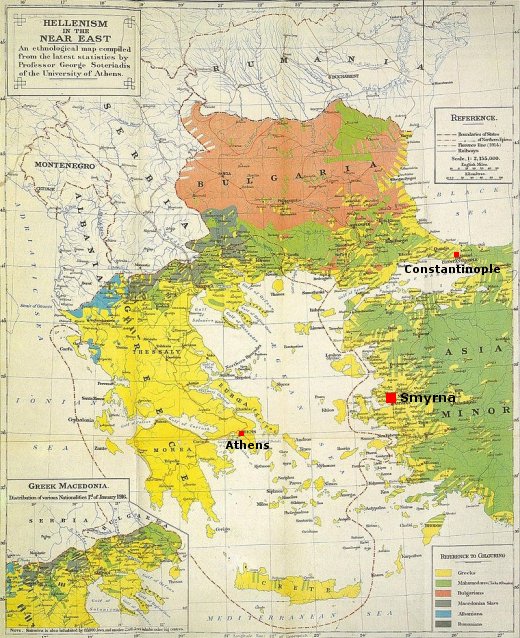 Distribution of Greeks (in yellow) before the expulsions & genocide (1914)
Distribution of Greeks (in yellow) before the expulsions & genocide (1914)
Smyrna Conquered by the Moslem Turks
When the Roman Empire split in two, Smyrna found itself in the eastern part that evolved into the Byzantine Empire with capital in Constantinople, also known as Byzantium but now known by its Turkish conqueror's name, İstanbul, which was the capital of the Ottoman Empire until its collapse in 1918/9. The Turkish capital moved east to Ankara with the end of the Ottoman Empire. When finally the Byzantine Empire was overrun by the Ottoman Turks, Smyrna passed into Turkish hands but overall retained its Greek and Christian Eastern Orthodox character, the non-Moslem inhabitants paying the Islamic dhimmi tax and thus providing a source of much needed revenue for their new rulers.
The Christian History of Smyrna
But let's backtrack to the New Testament time. The Smyrna congregation was founded by Paul during his third missionary journey (AD 53-57), Ephesus having been founded during his second (AD 49-52) trip, so this congregation was about 50 years old. The famous Bishop Polycarp, one of the post-apostolic fathers, was born there in 69 AD and was a disciple of the apostle John. He undoubtedly succeeded John as the bishop for the region (AD 108-117). He was martyred along with 6 others by being scourged and beheaded in AD 165 during what is known as the 'Smyrna Period' of martyrdoms. The book, the Martyrdom of Polycarp, purports to be a letter from the congregation of Smyrna reciting the particulars of his death which is well worth the read as it will give you a taste-in-the-mouth of what it was like to live back then. Like most of the early believers, Polycarp taught universal reconciliation which he undoubedtly learned from his mentor John, and spoke of the æonian or age-long punishment of the wicked and not an eternal hell, a doctrine which evolved later in Western Catholicism.
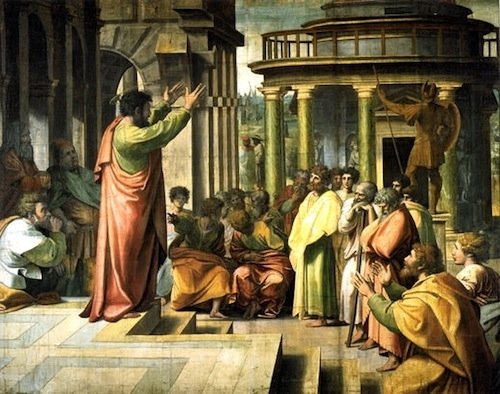 Paul preaching in Smyrna
Paul preaching in Smyrna
The Cult of Emperor Worship and Persecution
We don't know when the first wave of Roman persecution took place in Smyrna but like Ephesus and elsewhere in Anatolia when the cult of emperor worship was imposed, causing Christians/Messianics a dilemma - they had to choose between Caesar and Elohim (God) as their Master or Lord - but the impression Revelation 2 gives us is that the persecutions started pretty soon after the letter was delivered, reminding us once more that most prophecy concerned the immediate rather than the distant future. It did not end there either. Other important Christian fathers perished in Smyrna. Irenaeus was put to death in 202 during the persecutions of Severus. Cyprian died under the persecution of Trajan in 258 and Victorius in 304 under the martyrdoms of Diocletian. The blood of the qodeshim (saints, set-apart ones) flowed steadily into the ground in Smyrna, and it did not end with the first two or three centuries. This was a Martyrs' City.
2,000 Years Later...
In many ways, Smyrna is a lot closer to our own time than Ephesus for it had a vibrant Greek Orthodox Christian population right up until the early 1920's, a mere century ago, when my own father was a 10 year-old boy. One or two of you who are history buffs may have heard of the Treaty of Sèvres (1920) which the Allies tried to impose on the defeated Ottoman Empire following the conclusion of the First World War. In this treaty Smyrna and its hinterland territory was assigned to Greece which upset the Turkish nationalists who started a bitterly fought civil war (1919-22) when the Greeks started ethnically cleansing the region. Greece lost that war. At the end of it all, a painful and unequal exchange of populations between the Moslem Turks living in Greece and the Christian Greeks living along the coast of Turkish Anatolia, including Smyrna, took place - ½ million Turks were exchanged for 1½ million Greeks.
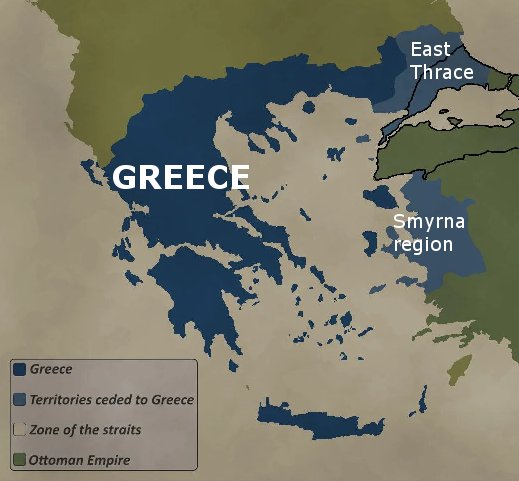 Greece was awarded the Smyrna & eastern Thrace regions but lost them
Greece was awarded the Smyrna & eastern Thrace regions but lost them
The Ethnic Cleansing of the Eastern Greeks
Understandably the Greeks did not wish to leave their ancient home. They had been living in Anatolia for nearly 3,000 years, remembering that the Moslem Turks in Europe were a more modern phenomenon. They invaded and colonised Anatolia following the capture of Constantinople and the collapse of the Greek-speaking Byzantine or East Roman Empire, so they had only been in Anatolia for about 5-6 centuries. This is not a short period of times. How many of us have nations stretching back 3,000 years? The USA is a mere three centuries old! The longer the settlement, the deeper the roots, and therefore the more painful and traumatic the uprooting, especially when it is sudden and violent and all traces of your history are systematically wiped out by the conqueror, your monuments and buildings demolished, your graveyards dug up and dessicrated. The Germans east of the Oder-Neisse rivers went through a similar ordeal after World War 2.
The Destruction of Greek Smyrna
To cut a long story short, Smyrna was lost to the new Nationalist Turkish Republic by conquest which was recognised by the Treaty of Lausanne (1923). The non-Moslem and non-Jewish inhabitants were either massacred or violently expelled. When the Turkish army arrived in September 1922, following the Greek defeat, they set about burning the Greek and Armenian quarters of the city to the ground and the heritage of nearly 3,000 years of that city - only the Turkish and Jewish quarters were spared. The raping, pillaging and murdering lasted between the 13th and 22nd of September with as many as 125,000 Greeks and Armenians massacred. Those that were captured were deported to the hinterland where they perished as the Armenians further east had been before them in the Armenian Genocide of 1915. Up to 400,000 refugees left Smyrna and the surrounding territories. After it was all over, the Turks demolished the Greek cathetral and any remaining Greek or Armenian buildings and a completely new city was built on the ashes and rubble. To this very day both nations are uneasy members of NATO now that the Soviet Union, which NATO was created to counter, ceased to exist in 1991. Greek and Turks have already come to blows in my time, in 1963-64 over possession of the island of Cyprus. Turkey invaded and split the island in two. I was 19 then.
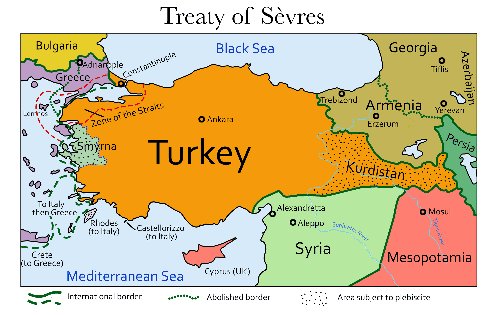 The original Allied partition plan for Turkey had to be abandoned
The original Allied partition plan for Turkey had to be abandoned
Turkish and Greek Attrocities
The evacuation of Smyrna was a particularly painful experience for its Greek inhabitants. Sometimes people do not appreciate the scale. In 1920 there were more Greeks in Smyrna than in Athens! The end of the war had upset the peaceful relationship between the Greeks, Armenians, Jews, Turks and others living in the city. When the Greek Army originally arrived and began advancing the Greek border deep into Turkish territory it started a program of ethnic cleansing that was reciprocated by the nationalist Turks who had already started an ethnic cleansing program of their own in 1915 massacring over a million Armenians, an attrocity they still refuse to admit to, let alone apologise for, to this very day. When the Turks finally drove the Greek Army out of Anatolia, dreadful things happened in this ancient and historic city with much of it being destroyed. Though the Greeks started the whole business off and the Greek army from the mainland invaded Turkey in a bid to greedily grab as much territory as it could, the Turks responded with even greater ferocity and barbarism. And the Allied navies in the harbour - the Americans, British and French - did nothing to improve the situation and even turned fleeing refugees away, leaving them to down in the harbourm demonstrating 'neutrality' in its worst aspect.
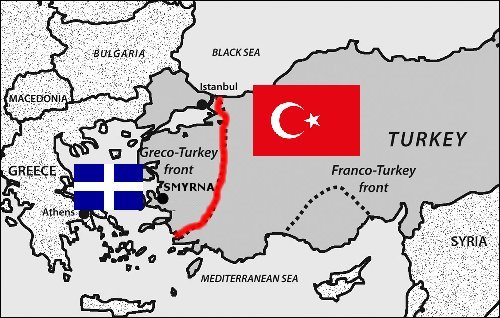 Extent of Greek penetration into Turkey in the 1919-22 war
Extent of Greek penetration into Turkey in the 1919-22 war
My Greek Connections
Having Greek relatives (my cousin married a Greek Cypriot) and many Greek friends, I know something about the tragedy of Smyrna, having heard terrible stories of what happened there from them. It burns in their memories, as does the loss of Constantinople, the loss of the headquarters of the Greek Orthodox Church, centuries even before that. My mother's first husband was killed in Greece in the Second World War, she knew lots of people there, I was contemplating moving to live in Greece on an island at one time to work as an English teacher for the British Council, and I myself came within a hair's breadth of marrying a Greek girl whom I had earlier led to salvation. Some of my good friends at Oxford University were Greek. Nevertheless as a Christian/Messianic, I am committed to bringing reconciliation between Greek and Turk, between German and Pole, between Serb and Bosniak, between Han Chinese and Tibetan, between white and black in South Africa, between Jew and Arab, because in Christ all animosity is healed and it is a commandment that we love one another. But first there must be proper repentance and that means owning up to sin and making sure justice is done in an impartial manner. That's an important part of the Besorah (Gospel, Good News) that far too many doctrinaire Christians and Messianics sometimes forget. When the time comes for Greek and Turks to make up, they must be honest about their respective historical behaviour.
Rome Supplants Greece
Had the Romans not ascended to power and come to control the Mediterranean and our own Western civilisation, European history might have been dominated by Greece even more than it was and we would have preferentially learned Greek rather than Latin at school. We British, and the Germanic peoples generally, have always held a great admiration for the Greeks and indeed my own upbringing and schooling was heavily influenced by Greek ideals, not that I agreed with all of them, mind you, as I was not the sporty Spartan type! I have always loved Greek architecture and art, though, particularly that of the Minoan civilisation. But I digress. So Greece is a strong part of all our Western heritage...and especially Smyrna which is perhaps our closest connection to the ancient past and to the Book of Revelation in particular. More than half the New Testament is to Greek-speaking people. If there are any survivors from Greek Smyrna, they are 100 years old or more now, so we must learn from their children's recollections while they are still alive.
Smyrna as a Great Commercial Centre
Why am I sharing all this history with you today? Because we know more about Smyrna than any of the other cities of the 7 congregations of Asia Minor and because of that we can make this prophecy become more alive and real to us. Smyrna is a tragic place, as places of beauty and commerce often are. I want to encourage you to connect with this place and sense its phronema, its mindset, its outlook, and to immerse yourself in something other than the 21st centurty. To understand scripture well you have to understand its times too. Smyrna, as a great trading centre, is also a lot like our own modern Babylonian world system. Not only did the city come to include Armenians, Jews and Turks, but by the 1600's merchants and their families from France, Venice, England and the Netherlands too. This was a cosmopolitan, 'globalist' kind of society, which the Moslem Ottomans tolerated because it brought them lots of revenue, as I mentioned, even if they did contemptuously call the city 'Gavur İzmir' or 'Infidel İzmir'. When money and religion mix, religion is the first usually to be compromised, the Moslems allowing Ionian alcohol and taverns in the non-Turkish parts. So many languages could be heard spoken there too. And it was money that brought them together.
Smyrna's False Messiah - Shabbetai Zivi
What most of you may not know is that Smyrna also acquired a reputation for heresy and the rise of a Jewish anti-messiah or antichrist. A decrpid and gouty broker names Mordecai Zevi, a Greek Jew, lived in Smyrna and one of his three sons called Shabbetai began to start seeing visions and immersing himself into kabbalistic studies. Kabbalism, which is a kind of Jewish occultism, had already been around for some time, having flourished in Spain and Ottoman Safed in Palestine in the late 1400's. The very moody Shabbetai Levi, who was almost certainly bipolar, led him into delusions of grandeur - a megalomaniac in today's talk - and he came to equate himself with Abraham, Hezekiah king of Judah, and Job. He even claimed to be able to levitate and though no one was able to confirm it even when they were watching him supposedly do it, he maintained they could not 'see' because they were't 'pure' enough. You get the picture. Something similar happened to the witnesses to the alleged golden plates of the Book of Mormon for though they claimed to 'see' them, in reality all they saw were 'visions' or 'hallucinations' of these mythical plates which conveniently 'vanished' into thin air when the angel that brought them took them away after 'translation'. Very convenient. So nobody actually saw Shabbetai Zivi levetate...because he didn't. We must be grounded in reality, a reason why the physical resurrection and appearances of Yah'shua the Messiah (Jesus Christ) before hundreds of witnesses are so important.
Shabbetai's Bizzare Teachings
False prophets and false messiahs often appear during times of crisis and Shebbatai Zevi was no different. In the 1640's the Cossacks were massacering Jews in Eastern Europe that led to a deep crisis within Judaism even as far away as Smyrna and the Mediterranean. Refugees brought tales of what had happened to the safe havens they found in the Ottoman Empire. The crisis was almost as bad as it had been in 1492 when their expulsion from Catholic Spain had unleashed earlier messianic fervour. Hearing of the crisis in eastern Europe, Shabbetai, now in his 20's, began to claim to be the Jews' long awaited messiah. He broke with rabbinical tradition and started speaking the word 'Yahweh' out loud instead of 'Adonai' or 'Lord', overturning a rabbinic superstition, and even contradicted several of the Torah mitzvah (commandments), even to uttering his own blasphemous prayer, 'Blessed are you, Lord our God and king of the universe, who permits that which is forbidden'. His wife Sarah was a whore and earned money as a fortune-teller. Shabbetai justified this by saying Hosea had married a prostitute.
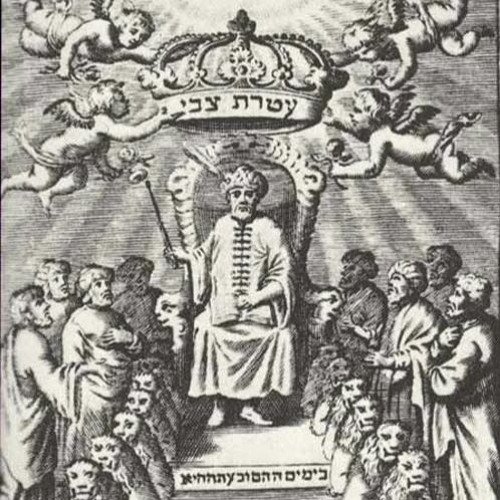 Shabbetai Zevi, the false messiah from Smyrna
Shabbetai Zevi, the false messiah from Smyrna
Numerous Influences
Anyway, to cut a long story short, he excited great fervour amongst the Jewish community, not just in Smyrna but throughout Europe, and gathered lots of followers who were taken in by his self-assurance and claimed prophetic skills. But when asked to perform miracles, he refused, with the excuse, 'I don't believe the Messiah will come in this way'. He and his followers stormed the Portuguese synagogue in Smyrna on 12 December 1665 which became their base of operations. What's particularly interesting is how he, like Mohammed before him, came under the influence of 'Christian' teachings, and in particular Christian apocalyptic. Now I say 'Christian' in speech-marks becase the influential Christian merchants in Smyrna were strongly under the influence Rosicrucianism themselves, a system of abtruse occultic knowledge, including alchemy, that arose in Germany following the terrible 30 Years' War between Catholics and Protestants. He was also influenced by 'Fifth Monarchy Men', the precursors of the Quakers, whose origin were full of apocalyptic expectation. So he was surrounded by corrupt, occultic mutations of Roman and Protestant Christianity too.
The Ignominious End of Shabbetai Zivi
This false messiah came to grief when he claimed to be the legitimate sultan of the Ottoman Empire and was, not unsurprisngly, swiftly arrested. He was offered the choice of proving himself to be the messiah through a miracle or converting to Islam. The miracle was straightforward enough - Turkish archers would fire arrows at his naked body and if he were the messiah he claimed to be, the arrows would pass through him without doing him any harm. He decided, with little hesitation, to become a Moslem instead. And that was the end of his career as Jewish saviour of the world. This caused devastation amongst his followers, many of whom converted to Islam too, thinking this was just a ruse on the part of their master.
Today's False Prophets
In every age, false prophets and messiahs arise in times of crisis. Ours is no different. Right now messianic fervour is sweeping through Evangelical Christianity because of Covid-19 and a whole host of other nasties cooked up by the élites. Examine these movements carefully and you will find the modern equivalents of 'Rosicrucianism'. Western Protestant Christianity has become heavily occultised whether in the liberalism of the traditional, established churches or the occult practices of the charismatic movement. Messianic fervour is at an all-time high as I speak to you. False prophets abound. Many, unwisely placing their trust in these charlatans, are going to be disappointed once again.
The Purity of the Late First Century Smyrnan Believers
The Smyrnan believers knew that persecution was on the way and when it came, they endured it, for however long those 'ten days' lasted in practice. They were not contaminated with false doctrines and practices - John the apostle had prepared them too well. There was no Mariolatry, no Calvinism, no endless hellfire-and-damnation talk, no jabbering in 'tongues', no wild behaviour, no sexual immorality, no prosperity gospel - none of the dangerous rubbish that infests Christendom today. The Smyrnan believers were marked, rather by "[good] works, tribulation and poverty" - they were being abused by the "synagogue of satan". Yes, they were Torah-obedient but they were not corrupted by rabbinical Judaism with all its false traditions and practices. They had, presumably, resisted the Judaisers who had earlier tried to infiltrate the new gentile congregations in the 50's and force circumcision on them. Considering Smyrna's history, which I have tried to outline today, they were remarkably pure, but were about to be tested to see if they would endure persecution too. And again, we see all the parallels with our own time.
Identifying the 'Synagogue of Satan'
They were a multi-national, multi-ethnic community. Next door, as it were, would have been a lively synagogue which rejected Yah'shua (Jesus) as Messiah and quite possibly actively blasphemed Him, perhaps even calling down curses upon Him. Remember, the word satan means 'accuser', so referring to the Jewish opponents as the 'satan-synagogue' (as N.T.Wright refers to it) would not have been inaccurate, if they were falsely accusing believers. Remember also that the Jews of this time held a special status in the Roman Empire which Christians/Mesasiancs did not enjoy - they were exempt from taking part in the imperial cult. They may have been accusing the believers before the authorities for not offering incense to Caesar and proclaiming Caesar as 'Lord' which they themselves, as Jews, didn't have to do.
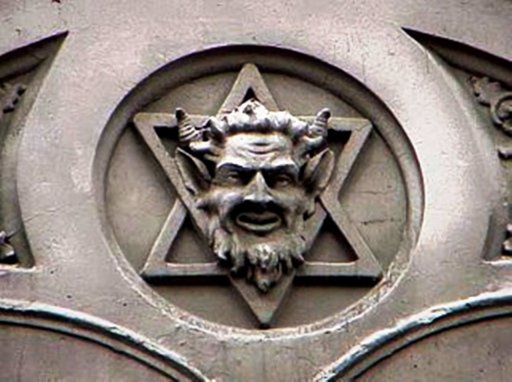
The Circumcised of Heart
They would, no doubt, have been aware of Paul's teaching in Romans chapter 2:
"For circumcision is indeed of value if you do what the Torah (Law, Teaching) says. But if you are a transgressor of Torah, your circumcision has become uncircumcision! Therefore if an uncircumcised man keeps the righteous requirements of the Torah, won't his uncircumcision be counted as circumcision? Indeed, the man who is physically uncircumcised but obeys the Torah will stand as a judgment on you who have had b'rit-milah (circumcision) and have Torah written out but violate it! For the real Judahite (Jew) is not merely Judahite (Jewish) outwardly; true circumcision is not only external and physical. On the contrary, the real Judahite (Jew) is one inwardly; and true circumcision is of the heart, spiritual not literal; so that praise comes not from other people but from Elohim (God)" (Rom.2:25-29, JNT/CJB).
The Stigma of Being Poor in a Wealthy Community
So John is not using a vague, abusive, 'anti-semitic' term in this revelation, but rather in a sharply defined sense that, as haSatan is literally 'the accuser', the synagogue in town has been 'accusing' the Smyrnan believers of all kinds of wickedness. That would have included not only the believers' refusal to participate in the imperial cult but the stigma of being poor whilst living in an otherwise very wealthy city (v.9). So don't let the Prosperity or 'Health-and-Wealth' preachers intimidate you, and don't be ashamed of being poor. If you are poor for Messiah's sake, that is, rather, a badge of honour, for you are rich in the Ruach (Spirit), and that's what matters.
Endure as Christ Endured
Again, please note, that Yah'shua (Jesus) finds nothing to criticise in the conduct of the believing Smyrnans! That cannot be said of any of the other six congregations. Perhaps that is a reason Yahweh permitted Smyrna to exist for so long, until the beginning of the 20th century, in spite of the sins of believers in later generations (Dt.7:9). The main task of the message is to warn that fierce persecution is on the way, and to endure it as the One who is "First and last, who was dead, and came to life" did so too as the Mortal Messiah.
Allusions to Death and Resurrection
Just as in Ephesus we find allusions to Paradise and the Tree of Life in the Temple of Artemis (Diana), so too, here in Smyrna, we find another allusion what would have been meaningful for to them - just as Smyrna had one been destroyed and rebuilt, so they, the faithful Smyrnans, will die and be resurrected one day, even if it is in persecution as martyrs. Whatever happens to them, they and their fate are safe in Yahweh's hands. The devil may well imprison and 'test' some of them for '10 days', a short period of time, but it will not last forever.
Crowns of Life
The warning is again surrounded by promises that are immediately relevant to the congregation under threat. Those who are "faithful all the way to death" (v.10, KNT), which is the only true kind of Christian/Messianic emunah (faith), as Yah'shua (Jesus) Himself had been faithful (Phil.2:7-8), will receive the "crown of life", resurrection life in the First Resurrection and a glorious millennium upon the renewed earth. Crowns denote royalty, the 144,000 firstborn, the firstfruits or bikkurim of the Resurrection. Again, another allusion is present, because Smyrna was thought of as a "city with a crown", due to the way its spendid architecture used the natural advantages of the steep Pagos Hill to good effect.
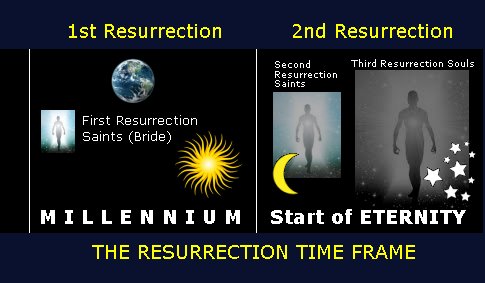
The Two Types of Death
Which brings us to the final promise and my conclusion to this study today. Quite naturally, there is a certain amount of apprehension at the thought of maybe having to face death for ones beliefs. Those not willing to die for their faith, even if in life they may not actually be called to do so, have not received a full spiritual regeneration, and are to some extent still in their sins. That doesn't mean they can't be fearful or apprehensive to some extent, because death is a fearful thing. In this letter to Smyrna Yah'shua (Jesus) reminds us that there are two types of death, the first of which is natural death which comes to all but the final generation of faithful ones. Yah'shua (Jesus) has already passed that way and those who belong to Him can know that He will first welcome them on the other side and then, in the end, raise them to new life in the final new world. But there is another death, a 'second death', for those who steadfastly and deliberately refuse to follow Yah'shua (Jesus), to worship the one true Elohim (God) who is revealed in Him. Whether that 'second death' means to be tortured in eternity, annihilated or purified over a long period of time and finally be reconciled with Yahweh whilst inheriting a lesser glory, is still the great controversy in Christendom that will separate out the Remnant from all the rest, for the Remnant believe in final, universal reconciliation. We will talk more of this when we come later to discuss chapter 20. Whatever the final fate of the wicked may be, the faithful still have to conquer or overcome.
Conclusion
With that, we'll end our study of Smyrna today. Next week we shall take a look at Pergamum. I hope you have found the Smyrna story as interesting, inspiring and faith-building as I did in preparing this for you. Yahweh bless you until we meet for the Rosh Chodesh message tomorrow. Amen.
Continued in Part 10
Endnotes
[1] Some, like the William Barclay New Testament translation (1969) overinterpret and write "inhabited world". Others, like the Hebraic-Roots Version (HRV) provide useful clarifying footnotes and explain that in Hebrew and Aramaic, eretz and a'ra, respectively, can mean the 'world' (e.g. Prov.19:4), the 'earth' (e.g. Dan.2:35) or 'land' (e.g. Dan.9:15) where 'world' is used as a euphamism for 'Israel' (e.g. Dan.9:6) in the same way that boastful Romans described their Empire as the whole 'world' which they wished to be the masters of. Again we see the importance of checking the primary language of revelation for meanings that might get lost in the Greek translations and thence pass over to our English ones.
Acknowledgements
[1] David Abulafia, The Great Sea: A Human History of the Mediterranean (Allen Lane, London: 2011), part 5, chapter IV, section I, A tale of Four and a Half Cities, 1918-1945
[2] Tom Wright, Revelation for Everyone (SPCK, London: 2011)
 Click the image for the whole Series
Click the image for the whole Series

 V323
V323
|


